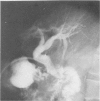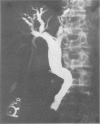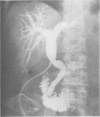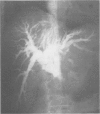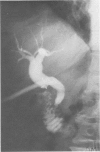Abstract
Percutaneous transhepatic cholangiography is a safe, effective diagnostic procedure for use in evaluating the jaundiced patient. As is the case with most invasive diagnostic procedures there is a risk: an overall mortality rate of 0.5% and morbidity rate of 3-10%. Fortunately hemobilia is an uncommon complication, encountered only four times in our series of 102 percutaneous cholangiograms. In every case of hemobilia the clotting parameters were normal. The one factor common to each case was distal obstruction of the extra hepatic bile ducts. However, this one factor may play an important role in the etiology and therapy of post cholangiographic hemobilia. The hemorrhage subsided spontaneously in every case following surgical decompression of the bile ducts and there was no further active bleeding postoperatively. The possible explanation for the cause of bleeding and the fact that it subsided following demcompression of the bile ducts is discussed. All four patients survived this complication and in the 102 patients there were no deaths attributable to percutaneous transhepatic cholangiography.
Full text
PDF






Images in this article
Selected References
These references are in PubMed. This may not be the complete list of references from this article.
- AMERSON J. R., FERGUSON I. A., Jr TRAUMATIC HEMOBILIA. Surgery. 1963 Nov;54:729–735. [PubMed] [Google Scholar]
- Ariyan S., Cahow C. E., Greene F. L., Stansel H. C., Jr Successful treatment of hepatic artery aneurysm with erosion into the common duct. Ann Surg. 1975 Aug;182(2):169–172. doi: 10.1097/00000658-197508000-00016. [DOI] [PMC free article] [PubMed] [Google Scholar]
- CREED D. L., FISHER E. R. Clot formation in the common duct; an unusual manifestation of primary hepatic carcinoma. AMA Arch Surg. 1956 Aug;73(2):261–265. doi: 10.1001/archsurg.1956.01280020075014. [DOI] [PubMed] [Google Scholar]
- Cox E. F. Hemobilia following percutaneous needle biopsy of the liver. Arch Surg. 1967 Aug;95(2):198–201. doi: 10.1001/archsurg.1967.01330140036009. [DOI] [PubMed] [Google Scholar]
- Evans J. A., Mujahed Z. Percutaneous transhepatic cholangiography. Conn Med. 1969 Dec;33(12):769–774. [PubMed] [Google Scholar]
- FLEMMA R. J., CAPP M. P., SHINGLETON W. W. PERCUTANEOUS TRANSHEPATIC CHOLANGIOGRAPHY. Arch Surg. 1965 Jan;90:5–10. doi: 10.1001/archsurg.1965.01320070007002. [DOI] [PubMed] [Google Scholar]
- FLEMMA R. J., SCHAUBLE J. F., GARDNER C. E., Jr, ANLYAN W. G., CAPP M. P. Percutaneous transhepatic cholangiography in the differential diagnosis of jaundice. Surg Gynecol Obstet. 1963 May;116:559–568. [PubMed] [Google Scholar]
- Levinson J. D., Olsen G., Terman J. W., Cleaveland C. R., Graham C. P., Jr, Breen K. J. Hemobilia secondary to percutaneous liver biopsy. Arch Intern Med. 1972 Sep;130(3):396–400. [PubMed] [Google Scholar]
- MANFREDI D. H. Gastrointestinal hemorrhage originating in the biliary tract. N Y State J Med. 1958 Jul 15;58(14):2397–2398. [PubMed] [Google Scholar]
- Redeker A. G., Karvountzis G. G., Richman R. H., Horisawa M. Percutaneous transhepatic cholangiography. An improved technique. JAMA. 1975 Jan 27;231(4):386–387. [PubMed] [Google Scholar]
- Steichen F. M., Sheiner N. M. Traumatic intrahepatic hemobilia. Arch Surg. 1966 Jun;92(6):838–847. doi: 10.1001/archsurg.1966.01320240026006. [DOI] [PubMed] [Google Scholar]
- Wallace S., Medellin H., Nelson R. S. Angiographic changes due to needle biopsy of the liver. Radiology. 1972 Oct;105(1):13–18. doi: 10.1148/105.1.13. [DOI] [PubMed] [Google Scholar]





